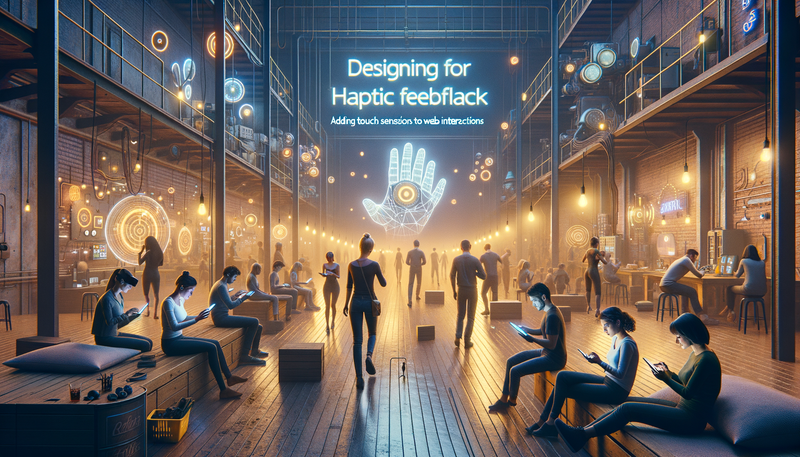Designing for Haptic Feedback: Adding Touch Sensations to Web Interactions
Haptic feedback is revolutionizing the way we interact with digital interfaces, bringing a tactile dimension to web experiences. This article delves into the world of designing for haptic feedback on websites, focusing on mobile and touchscreen devices. We'll explore innovative techniques to incorporate touch sensations that enhance user interactions and boost engagement. From subtle vibrations to more complex tactile patterns, learn how to leverage haptic technology to create more immersive and intuitive web experiences. Discover the potential of haptic feedback to improve user satisfaction, increase accessibility, and set your website apart in an increasingly touch-oriented digital landscape.Table of Contents:

Understanding Haptic Feedback in Web Design
Haptic feedback refers to the use of touch sensations to communicate information to users. In web design, it involves creating tactile responses to user interactions on touchscreen devices. This can range from simple vibrations to more complex patterns that simulate textures or movements. Haptic feedback enhances the user experience by providing physical confirmation of actions, improving navigation, and creating a more engaging and immersive interface.Implementing haptic feedback in web design requires a combination of hardware support and software implementation. Most modern smartphones and tablets are equipped with haptic actuators, allowing designers to tap into this technology through web APIs and JavaScript libraries. By thoughtfully incorporating haptic elements, designers can create websites that not only look and sound great but also feel responsive and interactive.
Do you need a website? Want to build a website but don't know where to start? Our website builder is the perfect solution. Easy to use, and with the ability to customize to fit your business needs, you can have a professional website in no time.
Benefits of Incorporating Haptic Feedback
Integrating haptic feedback into your website design offers numerous advantages. Firstly, it enhances user engagement by providing a multi-sensory experience that goes beyond visual and auditory cues. This can lead to increased time spent on the site and improved user satisfaction. Secondly, haptic feedback can improve accessibility for users with visual impairments, offering an additional channel of information.Moreover, haptic feedback can reinforce branding and create a unique user experience that sets your website apart from competitors. It can also improve usability by providing instant, physical confirmation of user actions, reducing errors and frustration. Finally, haptic feedback can create a more intuitive interface, making it easier for users to navigate and interact with your website, especially on smaller mobile screens where visual cues might be limited.
Techniques for Implementing Haptic Feedback
There are several techniques for implementing haptic feedback in web design. One common approach is using the Vibration API, which allows you to trigger vibrations on compatible devices. This can be used for simple feedback like confirming button presses or form submissions. For more complex interactions, you can create custom haptic patterns using JavaScript libraries such as Lofelt.js or Taptic.js.Another technique is to combine haptic feedback with other sensory cues, such as visual animations or sound effects, to create a more cohesive and immersive experience. For example, you could pair a subtle vibration with a visual ripple effect when a user taps a button. It's also important to consider the context and frequency of haptic feedback to ensure it enhances rather than overwhelms the user experience.
Building a website with SITE123 is easy
Best Practices for Haptic Feedback Design
When designing haptic feedback for your website, it's crucial to follow best practices to ensure a positive user experience. First, use haptic feedback sparingly and purposefully. Overuse can lead to sensory overload and diminish its effectiveness. Second, ensure consistency in your haptic design across different elements of your website to create a cohesive experience.It's also important to provide users with control over haptic feedback, allowing them to adjust or disable it if desired. Consider the context of use, such as public environments where vibrations might be disruptive. Additionally, test your haptic feedback on various devices to ensure compatibility and consistent behavior across different hardware. Finally, always prioritize the core functionality of your website, using haptic feedback as an enhancement rather than a replacement for clear visual and structural design.
Future Trends in Haptic Web Design
The field of haptic web design is continuously evolving, with exciting future trends on the horizon. One emerging trend is the development of more sophisticated haptic technologies that can simulate a wider range of textures and sensations. This could lead to more realistic and immersive web experiences, particularly in e-commerce and virtual reality applications.Another trend is the integration of haptic feedback with other emerging technologies such as voice interfaces and gesture control. This could result in more natural and intuitive ways of interacting with web content. Additionally, as wearable devices become more prevalent, we may see new opportunities for haptic feedback beyond traditional touchscreens, opening up new possibilities for web interaction design.





